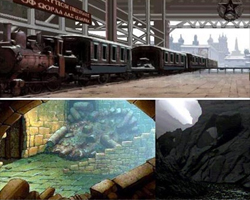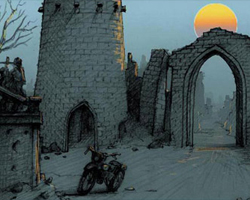Missing Pressumed? (IV)
The Kingdom of the Crystal Skull is already a world blockbuster. But neither Indy's return to the silver screen nor the adaptation of the character to the videogame scene were easy. Today we are telling you about the unredeemed Indys, the Indys from the nineties which never came to be adventure games…
# Paco García |

Things being so, the project was then started from scratch, without ever beginning preproduction on Garden of Life, now lost in some shelf who knows where, taking, deservedly as supposed, layers and layers of dust. But the Internet always have the answer for the curious ones, may it be in the form of a doubtfully official text file… Luckily for us all, the product that was eventually released is called Indiana Jones and the Fate of Atlantis, and would be named by many one of the best adventure games of all time.
Indiana Jones and the Iron Phoenix

The atlantian trip of Indiana Jones was a success even bigger than its first part, and, again, sales results kind of pushed the Californian company towards the creation of a new adventure to exploit the license. For that matter, Hal Barwood gave his baton to a novice Joe Pinney. Pinney worked for some time on the idea, named Indiana Jones and the Iron Phoenix, but left the company with an unfinished script, so the project ended up in the hands of Aric Wilmunder, who took charge of rewriting the story and the design of the game. The plot had a different setting than those of the previous adventures of Indy, and the game took place in the aftermath of WWII, with the Nazis finally defeated, being prosecuted and exiled secretly in Bolivia. Indy would then find in the dismantled Germany alchemical artefacts and ancestral manuscripts telling the story of the Philosopher’s Stone. New enemies would get into this story, the Soviets, who, under the leadership of a gorgeous commander dubbed “Comrade Major Legs” (who might very well be the origin of the sensually lethal Doctor Coronel Spalko from Indiana Jones and the Kingdom of the Crystal Skull), would put all kinds of restrictions to the amazing discovery of Dr. Jones. But that would not be the biggest of the problems he would have to face, since the remainings of the Third Reich were already planning a new master stroke with which to take over the world again: getting a hold of the Philosopher's Stone and resurrecting their Führer.
This project began in 1993 and was finally cancelled in 1995. In all this time all kinds of internal issues took place: the top authorities at LucasArts believed it was appropriate to hire third parties to develop the game, a practice very common in the company of these days. Aric Wilmunder relates: “The president of LucasArts had been contacted by a Canadian company that wanted to work with us, so for three months, we tried to teach them how to build the project, but they were never able to deliver the necessary quality”.
In the middle of the process of designing the concept of the game, and after the failure with the Canadian company, Wilmunder was overwhelmed by too much work: “I was the chief engineer of the SCUMM system, and Sean Clark had just been asked to finish The Dig, after two previous failures. One of his requirements was that I would be available to provide full engineering support for the project”. Besides all of that, The Iron Phoenix faced the obstacle of the censorship in Germany towards anything portraying the Nazi imagery. Previous games were finally slipped into the German market by just removing a couple of graphics and changing a few swastikas, but The Iron Phoenix change would have been much more complex, as the essential part of the story involved resurrecting Hitler; even the name of the game, which tacitly referred to the Nazi flag, would need a change. So adapting this game for Germany (which was already back then a huge portion of the adventure game market), would be extremely tough, not to say impossible.

Furthermore, the visual style of the characters also added some extra difficulties. There was a common belief commenting how the visual style for the game was somewhat undefined as a result of the disagreement of styles between the main animator, Anson Jew, and the background artist, Bill Stoneham, blaming the work of Jew for his deviation towards an Art Deco style. However, Anson Jew himself, a veteran artist in the company, remembers the details of his work in this project and makes some explanations on these assumptions: “It was agreed by all from the very beginning that the look of the characters would be realistically rendered like The Dig or Indiana Jones and the Fate of Atlantis (both of which I worked on) as opposed to the linear look of Full Throttle or Day of the Tentacle. The main improvement would be that the characters would be at twice as large as The Dig or Fate of Atlantis characters, and unlike those games, in normal human proportions. To create Indy, I started with the Indy from Fate of Atlantis and doubled his size in D-Paint/Animator and adjusted his anatomy to more realistic proportions. What I discovered was that from a rendering standpoint, things you could get away with on a 24 pixel tall character, you could not get away with on a 50 pixel tall character. In order to get a more 'rendered' look on a larger character, more colours would be needed to avoid colour banding”. These limitations made the character sprites not to look as expected, and as a result the backgrounds did not match the work done by Jew. “Doing large characters with an insufficient number of colours resulted in characters that looked flat like TV animation (hence, the 'Art Deco' or 'Batman Animated' label attributed by some to The Iron Phoenix characters). I approached the project leaders several times about allocating more colours to the animation palette to achieve this, but to no avail. As much as I like Art Deco and Batman Animated, making Indy look like that was never, ever my intention”.
Continues on next page
Page 2 of 3
« Previous | 1 | 2 | 3 | Next »
